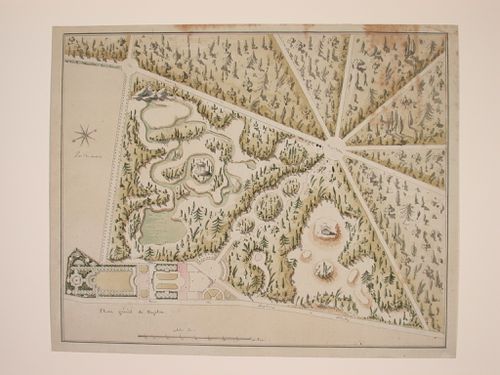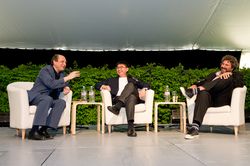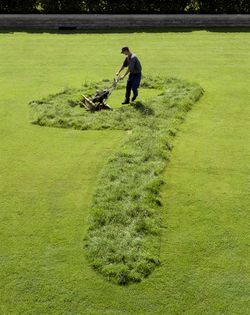textual records
DR2012:0012:094:013
1991
textual records
1991
DR1985:0358
Description:
- Ce plan général de Bagatelle présente en premier lieu la disposition des bâtiments: le pavillon de Bagatelle, au centre, est séparé du Bâtiment des Pages par la cour d'honneur sur sa droite; sur sa gauche, le pavillon présente une saillie semi-circulaire donnant sur le jardin où sont aménagés parterres et terrasses de forme symétrique. Cette enfilade de bâtiments et terrasses est séparée par un muret grillagé du jardin anglais; celui-ci s'allonge en forme de trapèze, délimité au nord par le Parc de Madrid, à l'est par le chemin de Madrid à Bagatelle, puis ce dernier s'incline pour rejoindre vers l'ouest le chemin de Longchamps à Neuilly.
architecture, landscape architecture
ca. 1778
Preliminary plan for the buildings and garden of Bagatelle, Paris
Actions:
DR1985:0358
Description:
- Ce plan général de Bagatelle présente en premier lieu la disposition des bâtiments: le pavillon de Bagatelle, au centre, est séparé du Bâtiment des Pages par la cour d'honneur sur sa droite; sur sa gauche, le pavillon présente une saillie semi-circulaire donnant sur le jardin où sont aménagés parterres et terrasses de forme symétrique. Cette enfilade de bâtiments et terrasses est séparée par un muret grillagé du jardin anglais; celui-ci s'allonge en forme de trapèze, délimité au nord par le Parc de Madrid, à l'est par le chemin de Madrid à Bagatelle, puis ce dernier s'incline pour rejoindre vers l'ouest le chemin de Longchamps à Neuilly.
architecture, landscape architecture
Series
Projects
AP144.S2
Description:
Series documents Cedric Price's projects from his early work in the late 1950s to work dating from the time he founded his own practice in 1960 until 2000. Material includes numerous competition entries, planning and building projects, transportation-related projects, exhibitions, conceptual projects, furniture and interior designs, and monuments, follies, and decorations. Some projects also reflect his teaching, research, lecture and publication activities. Price also worked on several competition juries (see projects Musique, Elephant). Many of Cedric Price's projects in the series are unexecuted. Significant unrealized projects from the 1960s and 1970s include Fun Palace (1961-1974), Potteries Thinkbelt (1963-1967), Oxford Corner House (1965-1966), and Generator (1976-1980). Significant built projects from the same period include the New Aviary (1960-1966), his first major realized project (with Lord Snowdon and Frank Newby), and Inter-Action Centre (1971-1979). Other realized projects include an office building (BTDB Computer, 1968-1973) and restaurant (Blackpool Project, 1971-1975). Planning projects from the 1960s and 1970s include Potteries Thinkbelt, Detroit Think Grid (1969-1971) and Rice University's design charette, Atom (1967). In the 1980s and 1990s, Cedric Price worked on several building proposals including greenhouses (Serre, Serre (2)), museums, galleries, and pavilions (Trafalgar, Pertpavs, Snake), a railway station (Strate (2)), a cultural centre (Tiff), houses (Perthut, Castel), a bus station (Walsall), an aviary (CP Aviary) and office buildings (Domain, Berlin). Planning projects from the same time include parks and cultural complexes, (Parc, South Bank), urban areas, (Strate, Stratton, IFPRI, Haven, Mills), university campuses (Frankfurt, Unibad, Bedford), and rural areas (Stark, Arkage). Transportation-related projects include railways (Strate, Control, Rink), roadways (Stratton) and pedestrian links (Magnet, Halmag, South Bank). Only a few of his projects from that period were executed and those include the renovation projects Congress and SAS 29; a mobile market stall design for Westminster City Council (Westal) for which prototypes were built; a coffee cup design (Crowbar); and building conversion projects Gatard and Juke. Exhibition projects in the series include some devoted to Cedric Price's works (AA Exhibition, Aedes, AFX, Afella), some designed by him (Strike, Food for the Future, Topolski/Waterloo, Ashmole, Mean, AFX), as well as projects designed for exhibition (Citlin, Castel). The series also contains self-financed research and client-less projects, which form a significant part of Cedric Price's practice. Undertaken in anticipation of future clients or new planning needs, they include research into air structures and lightweight enclosures as well as integrated construction and transportation solutions (Trucksafe Air Portable Dock Ahoy), and housing research. South Bank, Magnet, and Duck Land represent a few of the client-less projects. The material in this series documents Cedric Price's work in the United Kingdom, in particular England (the Greater London area, and other areas) and Scotland, Germany, France, Austria, Australia, Japan, the United Arab Emirates, and the United States and other locations such as Canada, Nigeria, and Norway. Major clients include J. Lyons & Co. (Oxford Corner House), David Keddie (Two Tree Island, Southend Roof), Howard Gilman (Generator), British Railways (Strate and Strate (2), and others), the McAlpine family , particularly Alistair McAlpine, and their company Sir Robert McAlpine & Sons Ltd. (McAppy, Perthut, Trafalgar, Pertpavs, Ashmole, Perth, Obeliq, McVance); Établissement Public du Parc de la Villette (Parc, Serre, Serre (2), Musique) and the Canadian Centre for Architecture (IFPRI, Mean). He collaborated with several architects and engineers during the course of his career, his closest association being with engineer Frank Newby and quantity surveyor Douglas Smith. Some of his other collaborators include engineer Max Fordham (Strate (2), Tiff, Berlin), engineering firms Scott Wilson Kirkpatrick and Partners (Stratton, Rink, Control), and Sir Frederick Snow & Partners (South Bank), cybernetician Gordon Pask (Kawasaki/Japnet), architectural firm YRM/Yorke Rosenberg Mardall (Unibad), and architect Richard Rogers (Marman). He also collaborated with members of Archigram on the Trondheim Competition, (1972-1974), and with John and Julia Frazer who provided the computer modelling for Generator. David Price, Cedric Price's brother was the model maker for several projects. The series contains conceptual drawings, design development drawings, reference drawings and maps, presentation drawings (particularly for competitions), and working drawings. A significant amount of textual records are included, especially for projects involving a large amount of research or publicity (Air Structures, Lightweight Enclosures, South Bank, CP Aviary, Stratton), for executed projects, and for the larger unrealized projects like Fun Palace and Generator. Also includes photographic materials of project sites and models. Some models included in the series are made from durable materials (wood, metal, plastic), while others are in-office constructions made out of paper, cardboard and Fome-Cor (TM). Of particular note are the 11 models for Magnet, and a full-size prototype of a market stall for Westal. Series also contains publication layouts, including material for the "Cedric Price Supplement", 'Architectural Design' vols. 40- 42 (1970-1972). Changes in office practice are noted around 1971, evident in the Blackpool Project and later, including the adoption of the metric system, and the creation of working and detail drawings on A4 size paper and filed with textual records (e.g. approximately 300 such drawings are included in the textual records for Blackpool Project). At the same time fewer preamble drawings that relate to site sensing, progress and life-cycle graphs and tables are created for the projects (a common feature from the 1960s), although project progress tables are still used. Of particular interest is material in the Early Work and Miscellaneous Records file (AP144.S2.D1) that relates to office work methods and programmes.
1903-2003, predominant 1960-2000
Projects
Actions:
AP144.S2
Description:
Series documents Cedric Price's projects from his early work in the late 1950s to work dating from the time he founded his own practice in 1960 until 2000. Material includes numerous competition entries, planning and building projects, transportation-related projects, exhibitions, conceptual projects, furniture and interior designs, and monuments, follies, and decorations. Some projects also reflect his teaching, research, lecture and publication activities. Price also worked on several competition juries (see projects Musique, Elephant). Many of Cedric Price's projects in the series are unexecuted. Significant unrealized projects from the 1960s and 1970s include Fun Palace (1961-1974), Potteries Thinkbelt (1963-1967), Oxford Corner House (1965-1966), and Generator (1976-1980). Significant built projects from the same period include the New Aviary (1960-1966), his first major realized project (with Lord Snowdon and Frank Newby), and Inter-Action Centre (1971-1979). Other realized projects include an office building (BTDB Computer, 1968-1973) and restaurant (Blackpool Project, 1971-1975). Planning projects from the 1960s and 1970s include Potteries Thinkbelt, Detroit Think Grid (1969-1971) and Rice University's design charette, Atom (1967). In the 1980s and 1990s, Cedric Price worked on several building proposals including greenhouses (Serre, Serre (2)), museums, galleries, and pavilions (Trafalgar, Pertpavs, Snake), a railway station (Strate (2)), a cultural centre (Tiff), houses (Perthut, Castel), a bus station (Walsall), an aviary (CP Aviary) and office buildings (Domain, Berlin). Planning projects from the same time include parks and cultural complexes, (Parc, South Bank), urban areas, (Strate, Stratton, IFPRI, Haven, Mills), university campuses (Frankfurt, Unibad, Bedford), and rural areas (Stark, Arkage). Transportation-related projects include railways (Strate, Control, Rink), roadways (Stratton) and pedestrian links (Magnet, Halmag, South Bank). Only a few of his projects from that period were executed and those include the renovation projects Congress and SAS 29; a mobile market stall design for Westminster City Council (Westal) for which prototypes were built; a coffee cup design (Crowbar); and building conversion projects Gatard and Juke. Exhibition projects in the series include some devoted to Cedric Price's works (AA Exhibition, Aedes, AFX, Afella), some designed by him (Strike, Food for the Future, Topolski/Waterloo, Ashmole, Mean, AFX), as well as projects designed for exhibition (Citlin, Castel). The series also contains self-financed research and client-less projects, which form a significant part of Cedric Price's practice. Undertaken in anticipation of future clients or new planning needs, they include research into air structures and lightweight enclosures as well as integrated construction and transportation solutions (Trucksafe Air Portable Dock Ahoy), and housing research. South Bank, Magnet, and Duck Land represent a few of the client-less projects. The material in this series documents Cedric Price's work in the United Kingdom, in particular England (the Greater London area, and other areas) and Scotland, Germany, France, Austria, Australia, Japan, the United Arab Emirates, and the United States and other locations such as Canada, Nigeria, and Norway. Major clients include J. Lyons & Co. (Oxford Corner House), David Keddie (Two Tree Island, Southend Roof), Howard Gilman (Generator), British Railways (Strate and Strate (2), and others), the McAlpine family , particularly Alistair McAlpine, and their company Sir Robert McAlpine & Sons Ltd. (McAppy, Perthut, Trafalgar, Pertpavs, Ashmole, Perth, Obeliq, McVance); Établissement Public du Parc de la Villette (Parc, Serre, Serre (2), Musique) and the Canadian Centre for Architecture (IFPRI, Mean). He collaborated with several architects and engineers during the course of his career, his closest association being with engineer Frank Newby and quantity surveyor Douglas Smith. Some of his other collaborators include engineer Max Fordham (Strate (2), Tiff, Berlin), engineering firms Scott Wilson Kirkpatrick and Partners (Stratton, Rink, Control), and Sir Frederick Snow & Partners (South Bank), cybernetician Gordon Pask (Kawasaki/Japnet), architectural firm YRM/Yorke Rosenberg Mardall (Unibad), and architect Richard Rogers (Marman). He also collaborated with members of Archigram on the Trondheim Competition, (1972-1974), and with John and Julia Frazer who provided the computer modelling for Generator. David Price, Cedric Price's brother was the model maker for several projects. The series contains conceptual drawings, design development drawings, reference drawings and maps, presentation drawings (particularly for competitions), and working drawings. A significant amount of textual records are included, especially for projects involving a large amount of research or publicity (Air Structures, Lightweight Enclosures, South Bank, CP Aviary, Stratton), for executed projects, and for the larger unrealized projects like Fun Palace and Generator. Also includes photographic materials of project sites and models. Some models included in the series are made from durable materials (wood, metal, plastic), while others are in-office constructions made out of paper, cardboard and Fome-Cor (TM). Of particular note are the 11 models for Magnet, and a full-size prototype of a market stall for Westal. Series also contains publication layouts, including material for the "Cedric Price Supplement", 'Architectural Design' vols. 40- 42 (1970-1972). Changes in office practice are noted around 1971, evident in the Blackpool Project and later, including the adoption of the metric system, and the creation of working and detail drawings on A4 size paper and filed with textual records (e.g. approximately 300 such drawings are included in the textual records for Blackpool Project). At the same time fewer preamble drawings that relate to site sensing, progress and life-cycle graphs and tables are created for the projects (a common feature from the 1960s), although project progress tables are still used. Of particular interest is material in the Early Work and Miscellaneous Records file (AP144.S2.D1) that relates to office work methods and programmes.
Series
1903-2003, predominant 1960-2000
photographs
ARCH256440
Description:
"Au vol d'oiseau, voici l'île Sainte-Hélène à son état naturel, il y a deux ans, avant le début des travaux de récupération qui ont presque triplé la superficie afin d'y loger l'Exposition universelle de 1967. Le magnifique parc boisé restera tel quel pour l'agrément des visiteurs. / Air view of Ile Sainte-Hélène, as of July 23, 1963, just before work began on the enlargement of the island to provide the ground for Expo 67. View is from the upstream end of the island. Stipulation in the program for building Expo 67 is the condition that the original Ile Sainte-Helene public park be left untouched."--Description.
23 July 1963
Aerial views of the Île Sainte-Hélène and Île Notre-Dame sites prior the enlargement and the creation phases were completed, Expo 67, Montréal, Québec
Actions:
ARCH256440
Description:
"Au vol d'oiseau, voici l'île Sainte-Hélène à son état naturel, il y a deux ans, avant le début des travaux de récupération qui ont presque triplé la superficie afin d'y loger l'Exposition universelle de 1967. Le magnifique parc boisé restera tel quel pour l'agrément des visiteurs. / Air view of Ile Sainte-Hélène, as of July 23, 1963, just before work began on the enlargement of the island to provide the ground for Expo 67. View is from the upstream end of the island. Stipulation in the program for building Expo 67 is the condition that the original Ile Sainte-Helene public park be left untouched."--Description.
photographs
23 July 1963
archives
Level of archival description:
Fonds
Hal Ingberg fonds
AP120
Synopsis:
Le fonds documente les activités professionnels de l'architecte Hal Ingberg (b. 1960). Il contient des dessins, des photographies, des esquisses, des panneaux de présentation, ainsi que des documents textuels qui comprend une sélection de projets développés ou réalisés entre 1991 et 2002.
1991-2002
Hal Ingberg fonds
Actions:
AP120
Synopsis:
Le fonds documente les activités professionnels de l'architecte Hal Ingberg (b. 1960). Il contient des dessins, des photographies, des esquisses, des panneaux de présentation, ainsi que des documents textuels qui comprend une sélection de projets développés ou réalisés entre 1991 et 2002.
archives
Level of archival description:
Fonds
1991-2002
Renowned for their innovative projects and thinking, Greg Lynn and Yung Ho Chang present issues of vital importance in contemporary practice. Individual presentations by Lynn and Chang are followed by a conversation moderated by CCA Director Mirko Zardini. The Urgency series reflects the CCA’s ongoing exploration of critical issues facing architecture and contemporary(...)
13 June 2008
Urgency 2008: Greg Lynn and Yung Ho Chang
Actions:
Description:
Renowned for their innovative projects and thinking, Greg Lynn and Yung Ho Chang present issues of vital importance in contemporary practice. Individual presentations by Lynn and Chang are followed by a conversation moderated by CCA Director Mirko Zardini. The Urgency series reflects the CCA’s ongoing exploration of critical issues facing architecture and contemporary(...)
archives
Level of archival description:
Fonds
Peter Rose fonds
AP046
Synopsis:
The Peter Rose fonds, documents the design and construction of the Canadian Centre for Architecture (1989) and a design for the redevelopment of the Old Port of Montréal, Master Plan (1992) by architect Peter Rose. Both projects include drawings, textual records, models and photographs.
1983-1989
Peter Rose fonds
Actions:
AP046
Synopsis:
The Peter Rose fonds, documents the design and construction of the Canadian Centre for Architecture (1989) and a design for the redevelopment of the Old Port of Montréal, Master Plan (1992) by architect Peter Rose. Both projects include drawings, textual records, models and photographs.
archives
Level of archival description:
Fonds
1983-1989
Mel Ziegler: Growing Concern
The front garden is a sign, a place both public and private, conveying the convictions and values of the households they frame. Growing Concern, a grass relief in Baile Park by American artist Mel Ziegler (b.1956), represents the North American obsession with the lawn. The artist considers the cultural obsession with the growth of our lawns to be symbolic of the taming(...)
Baile Park
16 June 1998 to 8 November 1998
Mel Ziegler: Growing Concern
Actions:
Description:
The front garden is a sign, a place both public and private, conveying the convictions and values of the households they frame. Growing Concern, a grass relief in Baile Park by American artist Mel Ziegler (b.1956), represents the North American obsession with the lawn. The artist considers the cultural obsession with the growth of our lawns to be symbolic of the taming(...)
Baile Park
drawings
AP178.S1.1990.PR02.001.1
Description:
Original file title: Parce de S. Domingo de Bonaval
1992-1993
Studies and plans, Parque de Santo Domingo de Bonaval, Santiago de Compostela (folder 1 of 3)
Actions:
AP178.S1.1990.PR02.001.1
Description:
Original file title: Parce de S. Domingo de Bonaval
drawings
1992-1993
drawings
Studies and plans, Parque de Santo Domingo de Bonaval, Santiago de Compostela (folder 2 of 3)
AP178.S1.1990.PR02.001.2
Description:
Original file title: Parce de S. Domingo de Bonaval
1992-1993
Studies and plans, Parque de Santo Domingo de Bonaval, Santiago de Compostela (folder 2 of 3)
Actions:
AP178.S1.1990.PR02.001.2
Description:
Original file title: Parce de S. Domingo de Bonaval
drawings
1992-1993


